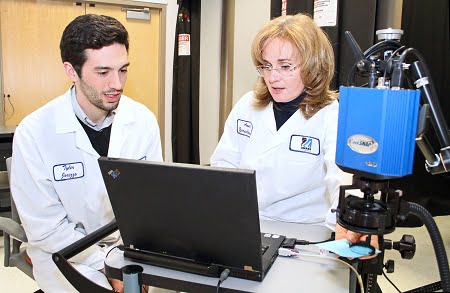Full company details
Edmund Optics Inc.
 101 E Gloucester Pike
101 E Gloucester Pike
Barrington, NJ 08007
United States
Phone: +1 856-547-3488
Fax: +1 856-573-6295
Toll-free: +1 800-363-1992
UMass Lowell Doctoral Student Wins Award for Cancer Imaging Device
BioPhotonics
May/Jun 2019A University of Massachusetts Lowell Ph.D. candidate in physics has won international recognition for his research work in developing an imaging device that could lead to improved diagnosis and treatment of certain skin cancers.

University of Massachusetts Lowell doctoral candidate Tyler Iorizzo, left, and professor Ann Yaroslavsky. Courtesy of UMass Lowell.
Tyler Iorizzo, who conducts research at UMass Lowell’s Advanced Biophotonics Laboratory, earned an Educational Award from Edmund Optics, a supplier of high-precision optics for the optical industry. He was awarded $7500 worth of Edmund Optics products that will be used in the Advanced Biophotonics Lab.
Iorizzo developed a device called an optical polarization imager (OPI), imaging technology that promises to improve success rates for diagnosis and surgery. It could also assist physicians in identifying the margins of nonmelanoma skin cancer prior to surgery, which would allow them to remove a malignant tumor with more precision, resulting in less complication and quicker recovery for the patient.
“Imaging with the OPI is completely harmless and noninvasive,” Iorizzo said. “It doesn’t use x-ray or high-intensity laser so it’s perfectly safe for the patient and the doctor.”
Ann Yaroslavsky, who is a UMass Lowell associate professor of physics and the director and founder of the Advanced Biophotonics Laboratory, said there is no other comparable tool available on the market.
“Surgeons basically look at the outline of a cancerous lesion visually and, based on their experience and training, decide where and how much tissue to cut,” she said. “In many cases, errors can arise because they can’t see the margins of the tumor very well.”